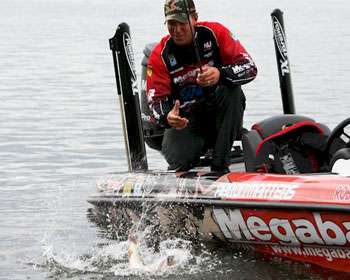
Had it not been for some last-minute heroics by eventual winner Takahiro Omori, Aaron Martens would have taken home the 2004 Bassmaster Classic victory on South Carolina's Lake Wylie.
Or, if awarded on the basis of "bass per gallon of gas," Martens would have run away with the title. He barely burned a gallon over three competition days. He merely idled 100 yards or so to the nearby Buster Boyd Bridge and set up camp. His strategy was good for a second-place finish.
The next year in Pittsburgh, he finished second again. The key structure? Several of the many bridges that span the Three Rivers fishery.
After that, the media referred to him as the "troll under the bridge," and he didn't bristle at the description. After all, Martens depends on bridges during many different seasons and all over the country.
He typically doesn't stop around the spans during the spawn, but he always checks them at other times. He'll check them out in the early spring and again in the fall, but his absolute favorite time is during the dog days of summer.
"A good time to fish a bridge is when it's unbearably hot, and you're really sweaty," he jokes. "That's when you want to get under the shade of a bridge."
It's not just the shade that draws the fish. This time of year, the prevailing conditions favor this environment. "Fish get off the bank and maybe go a little bit deeper," Martens explains. "This time of year, the oxygen levels are sometimes low, and bridges create a funnel that increases water flow. Under a bridge is usually a narrower portion of the lake, so you're going to find more current."
Indeed, while Martens made his name fishing bridges with 20, 40, 60 or more feet of depth around the pilings, he says a bridge doesn't have to span deep water to be productive, as long as there's good flow to provide multiple ambush points. Six to 8 feet of water is plenty if oxygen and food are abundant.
Unfortunately, fish around bridges, particularly in deeper water, are often suspended, and these can be some of the toughest bass to catch. "Those suspended bass are tricky," Martens allows. That's when he brings out some of his specialized tricks of the trade. At Wylie, he caught many of his fish on a home-poured "horsey head" jig tipped with a small fluke. Elsewhere he's been known to use his signature Scrounger Head. At times, he'll opt for a basic drop shot rig or shakey head worm.
The key, he says, is to "slide your bait down the pilings. If the bass are there, they'll usually bite."
Electronics are also key when fishing bridge pilings. Martens keeps a close eye on his graph, looking for baitfish and the telltale arches of larger fish in the area, but it's not just living creatures that draw his attention. He wants to know the irregularities of the bridge structure, whether they be concrete anchors or brush that has accumulated around the base.
Martens explains that many times the bass will position on one side of the bridge pilings. In order to find where the fish are positioned, he will fish each portion of the vertical cover from different angles to maximize his chance of locating and tempting inactive bass.
While there may be numerous bridges on the lake, Martens says there usually is a sweet spot where the bass will congregate. "One bridge or one piling is definitely better than the rest of them. I can't tell you why, but that's just how it usually is." That being said, Martens will often find several key bridges or bridge pilings throughout the lake and run a productive pattern. On Lake Shasta, in his native California, he's spent an entire multiday tournament seining several bridges, rotating from one to another throughout the day.





